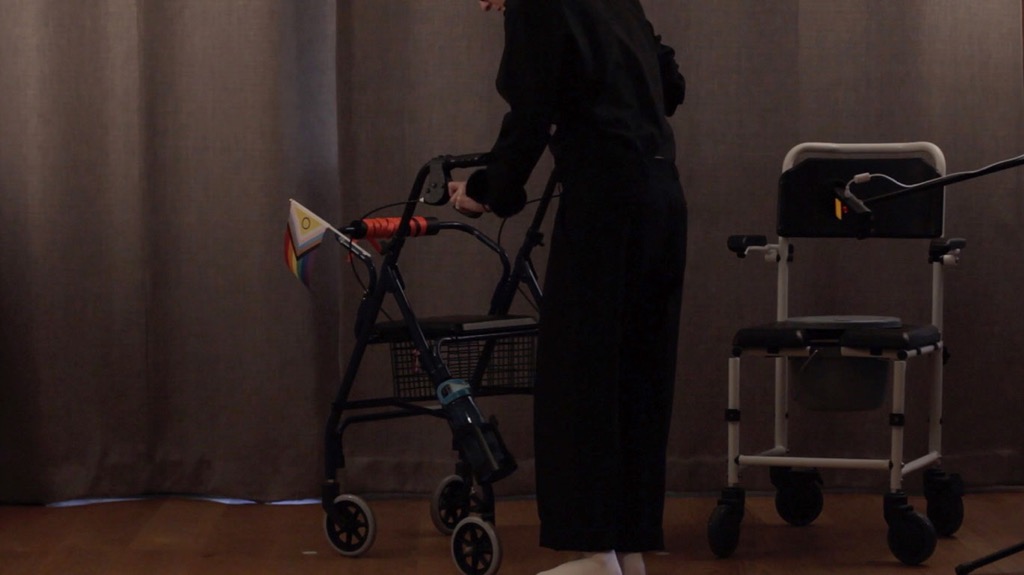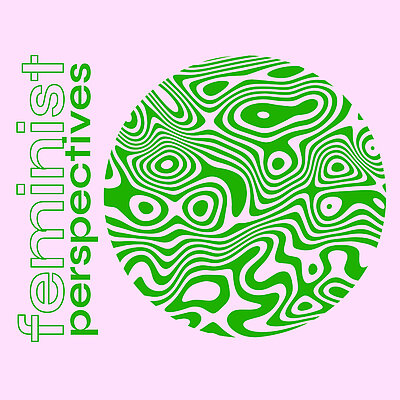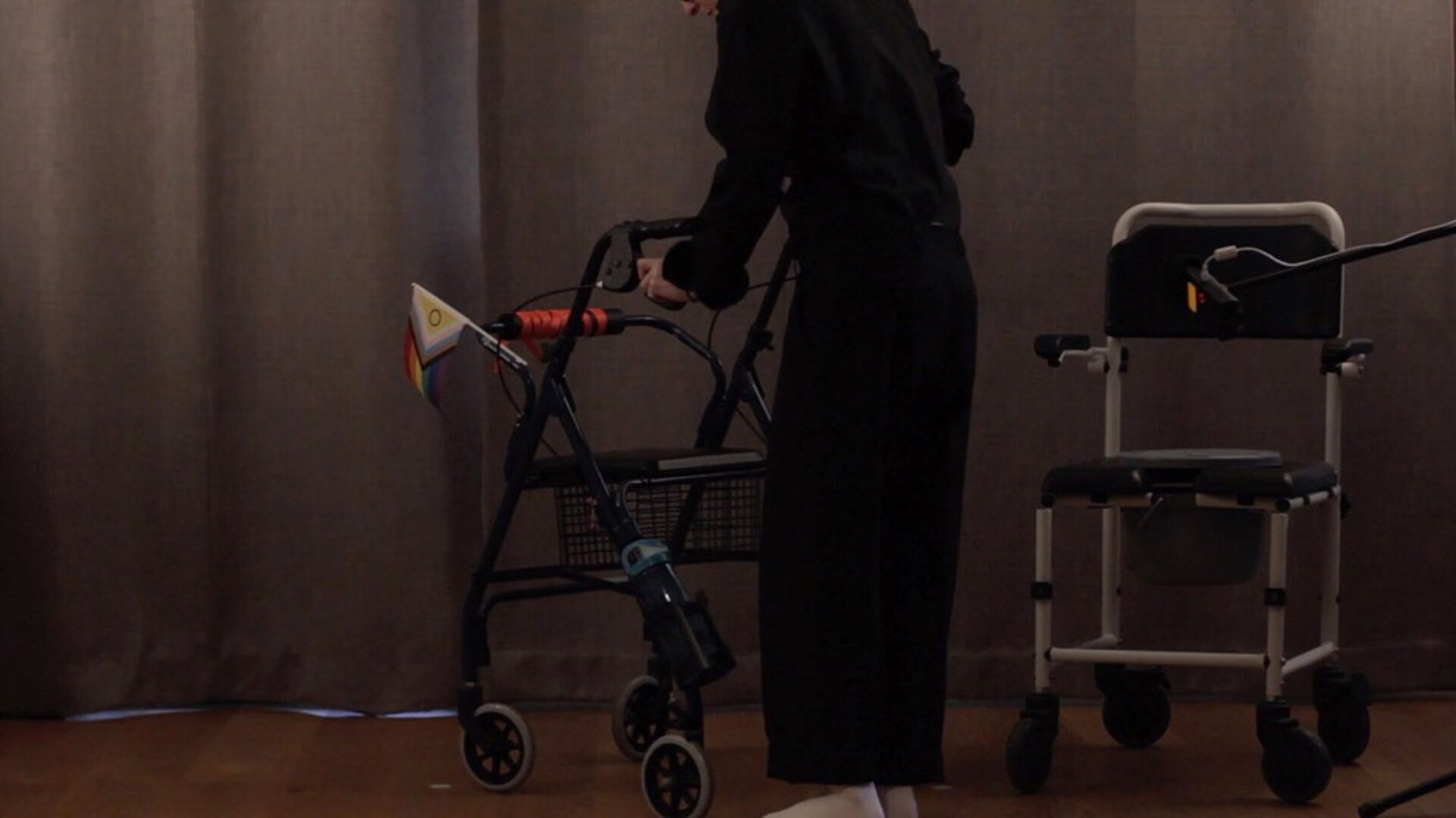
Saturday, December 6, 2025, 11 am to 1 pm
Feminist Perspectives
Program 1 | GAZES AND COUNTER-GAZES – Looking At Othering
Feminist Perspectives | Program 1 | GAZES AND COUNTER-GAZES – Looking At Othering
The first program is dedicated to the question of the gaze—that gaze which marks people as "other," excludes them, and renders them invisible, but also to the self-determined counter-gaze that exposes and rejects norms. The four films examine from different perspectives how disability and chronic illness are socially perceived and how disabled people and chronically ill people actively challenge these perceptions.
In Wo wir hingehören by Jonah Wögerbauer, the Deaf activist Xenia confronts us with Xenias own reflection: the freshly shaved head makes the cochlear implant visible—a conscious act of self-empowerment that anticipates and reverses the gaze of others. Through a photo project, Xenia stages a dialogue with other CI wearers and poses the question of belonging anew: Where do we belong? Who decides that? The title plays not only with the exclusionary gesture ("that's where you belong" in the sense of "not here"), but also refers to hearing itself—to the question of whom we listen to and how.
Bist du gelähmt, the participatory film by Gabriele Mathes from 1988, reverses an ableist phrase from Viennese dialect and turns it into an accusation: Bist du gelähmt (Are you paralyzed) when you pity, patronize, exclude. The film not only documents the demands of disabled people for social participation but turns the gaze back on "able-bodied" society. "We are not disabled, we are being disabled"—this central statement names the social construction of disability and makes clear that disability is not the problem, but rather the barriers that an ableist society erects.
Mario_n Porten's Ein Rollator für sich allein takes up Virginia Woolf's feminist demand for "a room of one's own" and translates it into the lived reality of a woman* living with ME/CFS. The camera focuses on a rollator that becomes the bearer of a sculptural accumulation of aids—toilet chair, sleep masks, medication box, all the way to the application for care allowance. Porten directs our gaze to an illness that makes those affected invisible because they must disappear into darkened, stimulus-reduced spaces. But instead of a narrative of suffering, she offers an ironic perspective that strategically deploys visibility: the sculpture makes visible not only the burden of illness but also the privileges necessary just to survive. The film is a call for solidarity and alliance.
Apolocalypse Core by RA Walden finally condenses the program's theme into an ironic reckoning in just three minutes. The karaoke video with its deceptively cheerful cloudscape turns out to be a dark dystopia: while others pack their "go bags" and build bunkers, the disabled person remains behind in their ground-floor apartment—"there's no-one here to lift me from my ground floor home". The song reveals the eugenic logic that runs through crisis scenarios and disaster preparedness: disabled life is imagined as expendable, as not worth surviving in times of apocalypse. "I'll die with eugenics in the warm red glow"—this refrain-like verse explicitly names what often remains unspoken in discourses about triage, resource scarcity, and chances of survival.
The four films follow the motto "Nothing about us without us," which shapes the entire festival. They show disability not as individual fate but as social construction maintained through gazes, language, and structural exclusions. At the same time, they stage counter-gazes that critically ask back: Who is allowed to be visible? Who is heard? Whose life is considered worth living? By using Disability Aesthetics as productive artistic practice, these films call on us to question the gaze prevailing in most societal discourses and to develop a post-ableist perception.
Information
PROGRAM 1
Saturday, December 6, 2025
11 am to 1 pm
GAZES AND COUNTER GAZES – Looking At Othering
- Apolocalypse Core (RA Walden, DE/UK 2024, 3 min) OV (EN, SDH)
- Wo wir hingehören (Jonah Wögerbauer, DE 2024, 15 min) OV (EN, SDH)
- Bist du gelähmt (Gabriele Mathes, AT 1988, 18 min) OV (EN, SDH)
- Ein Rollator für sich allein (Mario_n Porten, AT 2025, 19 min) OV (EN, SDH, integrated AD)
Followed by a conversation with directors and actors / performers
Moderation: Jannik Franzen
(in German, ÖGS)
Admission and screening is free; all you need to do is register online for a ticket. Please register for the slots only, that you can attend in person. Please exchange the ticket at the box office for a wristband, which also grants you free admission to all exhibitions at mumok on that day.
The organizers want to make it easy for everyone to join in by offering free admission, but appreciate a voluntary donation to help cover the costs. You will find the donation box at mumok cinema.
FILM SYNOPSES PROGRAM 1
Xenia looks at the freshly shaved head in the mirror. The cochlear implant is now openly visible—a conscious act of self-empowerment that requires great courage. As a Deaf activist who grew up in a hearing environment, Xenia moves between two worlds: sign language offers the greatest sense of comfort, while communication with the father relies on spoken language. Through a photographic project, Xenia initiates a dialogue with other CI wearers. Together they explore questions of adaptation, dependence, and belonging—between worlds, between different forms of communication, between visibility and invisibility.
The film addresses these in-between spaces: Whose gaze determines where someone "belongs"? Who is seen, who is overlooked? The title plays on multiple levels with language and exclusion. "Da gehörst du hin" (that's where you belong) in German means both "that serves you right" and spatial and social exclusion—we don't want to see you here, you don't belong here. At the same time, "hingehören" (to belong) resonates with "Hören" (hearing) itself: where we belong through hearing, where we direct our listening, how we listen, in what ways, and to whom.
Xenia's self-staging with the visibly revealed CI thus becomes a political statement: Xenia anticipates the pathologizing, normalizing gaze and reverses it. By bringing other CI wearers in front of the camera, Xenia creates a space of self-representation where people speak not about but from and with Deaf people. The film interweaves documentary with staged elements and makes clear: belonging is not determined by biological or technical conditions, but by recognition, the act of listening, and the willingness to build bridges rather than barriers.
Vienna, 1988: Gabriele Mathes makes a participatory film with disabled people who demand their active participation in all areas of society—long before inclusion became a political buzzword. One of the protagonists is the then still young Conny Scheurer, who today works as an important actor in the Austrian Danceability scene and as an exhibition curator. Her most recent exhibition was tellingly dedicated to "the aesthetics of the ramp"—a theme already present in Mathes' film: the aesthetic and political dimension of barriers and their overcoming.
The Viennese slang expression "Bist du gelähmt" (Are you paralyzed) is used in dialect to express, in a vulgar way, astonishment about a circumstance or event—one of many ableist phrases unconsciously used in everyday life. Mathes' film takes this linguistic turn literally and opens a radically new reading: "Bist du gelähmt" is not deployed as a derogatory phrase but reversed as a question: Are you paralyzed when you are seen differently, looked at differently, pitied, patronized, excluded.
The film reverses the gaze and lets disabled people look back at "able-bodied" society. It documents their astonishment at how non-disabled people perceive disabilities—or rather: how they make disabled people into objects of pity, patronization, or invisibility. Central to this is a sentence that would become a mantra of the international disability movement: "We are not disabled, we are being disabled." This formulation precisely names the social model of disability and makes clear that physical or mental differences are not the problem, but rather the social barriers that prevent people from participating.
Mathes' film, awarded in 1988 at the Vienna Student Film Festival for Best Direction and Screenplay, is an early and impressive document of a movement fighting for self-determination, visibility, and radical participation. It shows Vienna as the site of activist awakening and makes clear: the question is not whether disabled people "fit" into society, but when society will finally dismantle its exclusionary structures.
A reckoning disguised as a karaoke video with the perception of disability against the backdrop of an otherworldly, computer-generated cloudscape, where the desire to sing along quickly fades. While others pack their "go bags" and build bunkers for the apocalypse, the disabled protagonist remains behind in the ground-floor apartment—there is no one who could provide the necessary support for escape.
The song reveals the eugenic logic that runs through crisis scenarios and disaster preparedness: disabled life is imagined as expendable, as not worth saving in times of catastrophe. "I'll die with eugenics in the warm red glow"—this refrain-like verse explicitly names what often remains unspoken in discourses about triage, resource scarcity, and chances of survival. The deceptively cheerful aesthetic of the karaoke video stands in sharp contrast to its dark dystopian message and makes visible the structural violence of a society that considers some lives more worth living than others.
packed myself a rucksack
got a go bag by the door
got a tent and a poncho and my water filtration straw
I told all my care team I don't need them anymore
you can pack your bags and get your shit ready to go
you can build your bunkers and test your ham radios
but there's no-one here to lift me from my ground floor home
so I'll die with eugenics in the warm red glow
yes I'll die with eugenics in the warm red glow
I'll die with eugenics in the warm red glow
Virginia Woolf's iconic 1929 essay A Room of One's Own is repurposed by Mario_n Porten and transformed into a rollator that one has "for oneself alone." Woolf's essay was based on lectures she gave in 1928 at two women's* colleges in Cambridge. At the center is the relationship between women* and literature, particularly the material and social prerequisites that women* need to be able to write: according to Woolf, "a room of one's own and 500 pounds a year"—that is, financial independence and one's own space.
This image of a place that allows women* retreat, thinking, writing, and being-for-oneself is metaphorically overlaid by Porten with the recording of a rollator set up in a film studio. It becomes symbolically loaded with the burden of her severe chronic illness ME/CFS (Myalgic Encephalomyelitis/Chronic Fatigue Syndrome) by stacking the aids and tools she needs to manage her life on it. A kind of freedom is overwritten by the representation of dependence on instruments meant to make life easier: in voice-over we hear Porten's voice: "I pack on my rollator my toilet chair, my sleep masks, my pulse monitor, my medication box, my wheelchair, my bedpan, my sunglasses with homemade side sun protection…," until at the end the "application for care allowance" is visibly attached as well.
Porten also tells how "people become 'invisible' through this illness and completely disappear from their social lives because they must spend most of their time alone in a darkened, low-stimulus room." Our gaze at this illness meets Mario_n Porten's ironic perspective: "Instead of a story of suffering, as is currently often told in the media ('long-Covid' fates), here the construction of a sculpture from medical-care aids serves to make the illness visible and bring it to attention. The stacked objects—toilet chair, noise-canceling headphones, sleep mask, compression stockings, medication box, an application for care allowance—illustrate the illness and clarify its symptoms and challenges. There still exist many prejudices and great ignorance in society about this disease, which predominantly affects women*, especially among doctors and case workers at health insurance companies. (…)" (Mario_n Porten)

© mumok – museum moderner kunst stiftung ludwig wien
